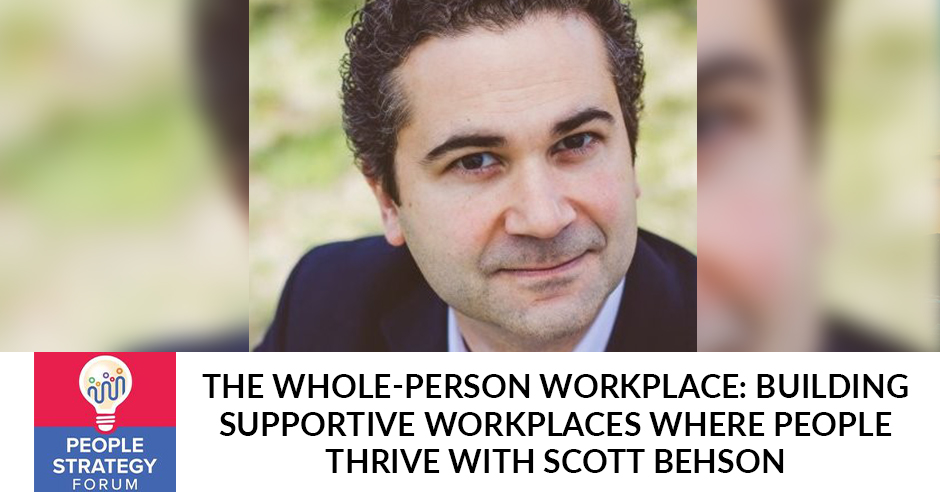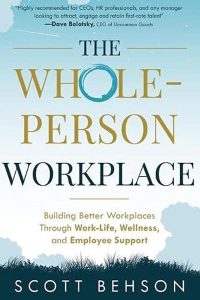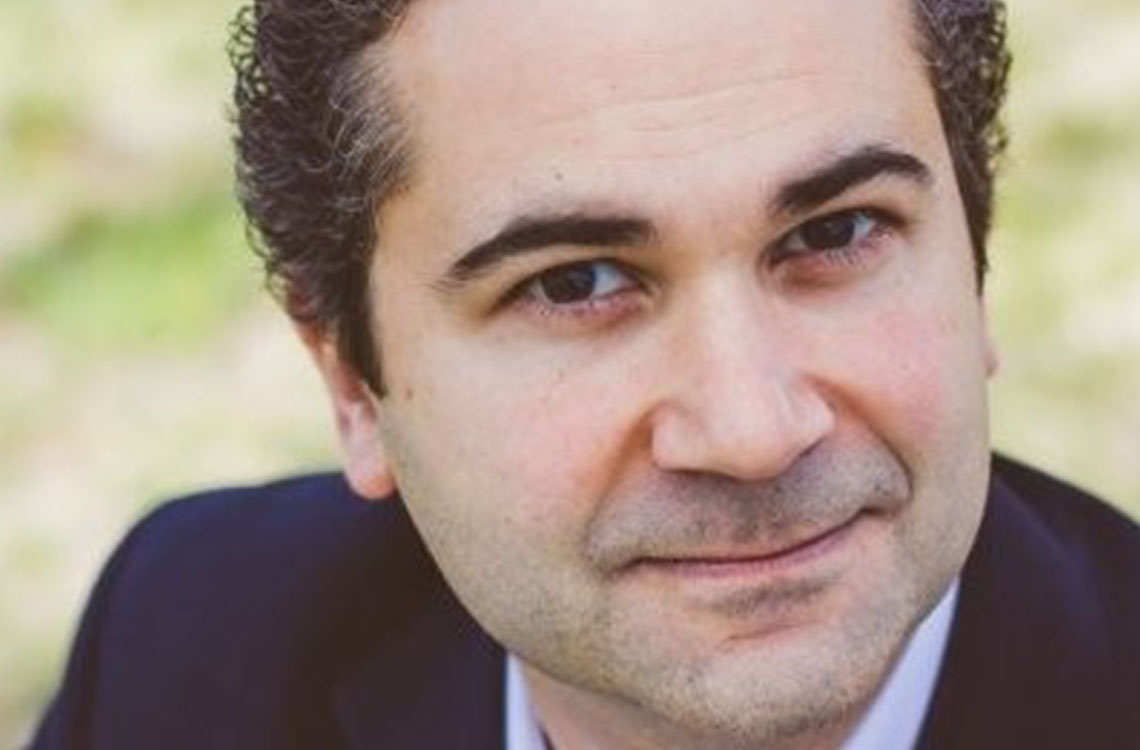The Whole-Person Workplace: Building Supportive Workplaces Where People Thrive With Scott Behson

A truly supportive workplace doesn’t stop outside the walls of the office. It takes care of its people not just at the workplace but also in the other parts of their lives. This is what the concept of the whole-person workplace means, and there is no better person to discuss this than Scott Behson. He is a Management Professor at Fairleigh Dickinson University. He is also a speaker, consultant, and author of three books. His new book, The Whole-Person Workplace, is the reason why we’re all tuned in. Tune in as he joins the People Strategy Forum and shares his wisdom and experience in all things talent management and human resources. Find out what a supportive workplace really means and how things like employee engagement, workplace culture, and diversity and inclusion fit into the whole picture.
—
The Whole-Person Workplace: Building Supportive Workplaces Where People Thrive With Scott Behson
We are so excited to have you here, whether you are coming on for the very 1st time or the 50th time, maybe the 100th time. In this episode, we have a fun topic. We are talking about the whole-person workplace with Scott Behson. Here at the show, if this is your very first time and you have no idea what goes on, we are here to engage, energize, and elevate your employees and company.
We do that by coming together with a panel of expert hosts. They have experience in so many different topics, including talent management, compensation, human resources, strategies, and more. We also bring on a different guest speaker every week. We change it up all the time. You’re sure to get some value each and every week so I encourage you to come back and hop on to get the most out of it.
When I did say we have a panel of expert hosts, I wasn’t lying. Here they are. Let me introduce you to everyone. We have Char who is a former HR professional. She is an entrepreneur now. She has cofounded many businesses and is working on a new business, which will assist seniors, which is very exciting. She’s also a career coach and consultant as well.
We also have Sumit. He logs in from India so we’re very global. He is a people strategist and consultant. He has helped and continues to help many different companies of various sizes, restructure their HR processes, and transform them in many different areas, including strategy and DEI as well. We also have Howard who is part of the CompTeam crew. He is a compensation expert and advisor who has helped many companies restructure their compensation department and make them run more efficiently.
We also have Wendy, another part of the CompTeam crew. She is a people strategist, talent management expert, and communications expert as well. Lastly, we have Sam who brings us all together but is also the Founder and CEO of CompTeam. He knows all about compensation and talent management initiatives. He’s a globally certified compensation expert as well. That is our panel.
That brings me to our guest speaker. We have Scott Behson. He is a Management Professor at Fairleigh Dickinson University. He has written three books and his new book, The Whole-Person Workplace, which is why that is also the topic of this episode. He’s also a speaker and consultant so we’re very excited to welcome Scott. Thank you so much for giving us your time. We’re excited to learn so much from you.
I’m happy to be here. Let’s get going.
Scott, to kick things off, I’d love to hear a little bit about you. You got into not just the teaching profession but what drove you to write The Whole-Person Workplace and so forth? Can you tell us about that?
I started studying things like workplace flexibility and work-life considerations back in my doctoral student days in the very late ‘90s. It’s been something I’ve been invested in for a long time before it was cool and what everybody does now. I’ve been a Management Professor for a long time and I teach things like Human Resource Management and Organization Behavior.
I’ve done all the traditional research and all the check marks you’re supposed to do in an academic career. After getting tenured and promoted to full professor even, I had a mid-career crisis. Aside from teaching, which I still love and energized me, I started losing interest in writing very academic jargony stuff that maybe only the other 75 professors who also studied the same things would read. It takes a year and a half for these things to get published. It was frustrating. I’m like, “What do I really want to do here?”
I decided what I want to do is have an impact on helping with work-life considerations. I started this back in 2012. I started a blog. I was like, “Who needs good information on this?” It’s working parents and employers. I started with the working parents’ part. In 2012, I started a blog called Fathers, Work, and Family to give advice and encouragement based on best practices, research, and my perspective both as a dad and as a management professor.
It’s advice and encouragement for dads trying to balance work and family. It was a real gap in what we were talking about. It was becoming pretty successful quickly. That led to my first book project, which was the Working Dad’s Survival Guide, which came out in 2015. That opened a lot of doors for me to do lots of other things.
I shifted my attention a few years back to the employer side. What do employers need to know to help people with their work-life considerations? That’s the work that eventually became The Whole-Person Workplace and my other work around that area, including Flex-Friendly Certification, which is a venture I’m involved in.
It was interesting too so I got my book contract in very late 2019 and started prepping the book and everything through the early months of 2020. I lined up all my interviews with Chief Human Resources Officers, CEOs, small business owners, and other experts for March, April, and May of 2020. The book is going to be pretty narrowly focused on work-family stuff, things like parental leaves. “Let people work from home every now and then when they need to,” and stuff like that.
March 2020 happened. I kept all my interviews. They were nice enough to do this back when the world was at peak uncertainty. I talked to all these leaders at a time when they were trying to navigate and think through like, “How do I keep my business in business? How do I take care of my people during this time?” It became clear over the interviews that the two challenges were the same. Taking care of my people through this crisis was how I kept my business going and thriving through this emergency situation.
A lot of this thinking right then was reflected in this book. The book became of the moment a little bit and the title, The Whole-Person Workplace, came out from some of the interviews that I did. One person I interviewed said, “We have to realize we get the whole person through the door. We get their backs, hands, minds, and hearts. There are all different stages in their lives. We have to do what we can.” That’s so beautifully said.
Your next question will be, “What is the whole-person workplace?” It gets to the values of that. We look at an employee not just as a part of the machine or just as an employee but we value employees more than that, as a whole person with lives, priorities, challenges, stressors, and anxieties outside of work. As an employer, we should think about employees that way and see what we can do to support employees in a larger context than we’re used to thinking about.

The Whole-Person Workplace: Building Better Workplaces through Work-Life, Wellness, and Employee Support
With the whole-person workplace, the concept is not new. We were talking about this a long time ago before the pandemic and so forth but do you think this was accelerated because of what we went through?
No, entirely. Ironically, the fact that people working in the workplace as much and people were on screens as we are now, you could see that I have family pictures here and knickknacks. Sometimes my cat walks through and sometimes my son comes home from school and he’s in the background. We got to see each other’s lives a little bit. It’s being forced to work from home even when it was convenient during the first year and a half of the pandemic. We got to see a lot of these other life stressors.
Luckily, my son was in high school but people with young kids were dealing with online school for young kids and working from home, maybe in a smaller apartment or sitting at the same dining room table. We all became more empathetic to some of the work-life challenges that we all face, leadership, and employees.
Secondly, the last few years have been an absolute ringer emotionally for so many people and levels of depression, anxiety, stress, and burnout. You think about some professions like healthcare and other areas, the amount of overwork, stress, burnout, and anxiety has led to a crisis. Many people are not themselves. We’ve all dealt with anxiety and loss for a long time.
I work with an age group who were 19 or 20 who didn’t go to prom because they didn’t have a prom or graduation ceremony. They lost all these things. People still have those scars and they bring them with them. That’s a long way of saying that smart organizations recognize that these stressors, anxieties, experiences, and loss are things that an employer should try to help address if you can.
One, it helps take care of your people and we should care about our people. Secondly, it builds a culture of mutual care where if the employer is stepping up for employees, they’ll step up for each other and you. It’s both the right thing to do and good business to be doing this. In my observation of all my interviews and everything from the book, the companies already had some of this in place.
We should care about our people. It’s the right thing to do and it’s good business to do it. Share on XWe’re ten steps ahead when the pandemic came because their teams already knew how to communicate and care about each other. Even though they had to go distributed, they were still able to make it work. They were somewhat dedicated to making it work and wanted the company to keep going so they pitched in.
Organizations that work was just a transaction of time for money lost a lot of people. People did the minimum. People didn’t feel like they were being taken care of and they weren’t receiving some of the support they needed. That’s the whole-person workplace approach. We should value employees in a certain way. If we do that, then we think about how we manage employees and what kinds of benefits and other things we offer employees that can maybe help them with not just their work challenges but also their life challenges.
I would love to reflect on when you were talking about how this has changed and how far we’ve come over the past years. Several years ago, when we started this remote work and we were all confined to our homes as our new office, we’ve seen some of the shocks that would happen. For instance, the newscaster where one of his children came into the office during a broadcast. This was on the BBC or something, I believe. He was shocked and horrified and was like, “What do I do?” There were a couple of cases that this happened. Many of them completely ignored it like it would go away or maybe somebody didn’t notice.
I remember that very distinctly. I was in this work-life so I had been able to do some media and things like that. It was NBC News that had me on to comment about that incident with that professor who had a remote hit for CNN, I think it was. His baby comes in and then his wife comes in to get the baby out and things like that. That was remarkable. “How could this happen?” Now, that’s normal.
Sumit often has a friendly invader that comes onto his screen. What I love about Sumit is that he’s an animal lover and everybody loves animals and so forth. I feel like those interruptions are things that bring that little bit of sweetness to the experience.
My students during COVID teaching online loved it when my cats came by, positively. I encouraged it because it did break things up a little bit. People smiled. We had a snow day here in New York. My university went remote but we could teach during snow days. I taught a Zoom class for the first time since ’21. My cat walked by a bit. We saw an animal walk by a little earlier in the conversation. My students were like, “Oh, my God.” It’s nice that we got to break things up a little bit.
I keep a bag of treats handy when I don’t have an answer to a quiet question. I dang it somewhere around. It gives me a couple of minutes to regroup and be ready.
My question is not as fun as this conversation. Scott, what you said is that the first thing that has to happen is that employers have to value their employees. For me, that was the hook. How do we do that? That seems so natural but in a smaller organization, it seems easier, especially with these bigger organizations. I would love for you to talk a little bit more about that first step and how to help our people who are reading think about that for their organization.
First off, what are our core values when it comes to employees? Articulate those. This needs to be sincerely helped. We want to be an employer of choice. A lot of companies talk the talk but don’t do the work behind it. That’s interesting too. A lot of companies will very positively say, “Employees are our most important asset.” I’m like, “That’s not as good as it can be. That’s better than a lot of ways to value employees.” Still, why do we take care of an asset only so it returns on the investment that we put in it? It limits it a little bit. We could do better than that.
I propose that the whole-person workplace value is we care about our employees not just at the workplace but we care that they’re doing well in the other parts of their lives. Articulating values at a large organization, maybe that has to be a process where we get leadership teams together and things like that to do that.
The whole-person workplace is where we care about our employees not just at the workplace but also in the other parts of their lives. Share on XIn a small business, a lot of people are mission-driven when they started a business or they started their own business and dropped out of Corporate America because they wanted to do things differently or a certain way. That’s a little more of a natural fit. Regardless of where you start with that, what you need to do is embed your values in what you do.
A lot of workplace wellness and well-being and even diversity and inclusion tend to be add-ons that human resources is in charge of. That’s not quite good enough because that’s just an add-on to other things. It’s not as important and it can go away. We’re seeing some of that but when it’s embedded in what we do, then diversity and inclusion or employed wellbeing are built into things like how do we hire people?
How do we onboard people? How do we perform that might allow for more flexibility? How do we redesign work so people aren’t overloaded and can take a vacation? Maybe overlapping team responsibilities and things like that. Allow someone to be able to not have to be connected to work after hours. That’s a job design question that could be embedded in how we operate.
For CompTeam, what’s our attitude towards pay, total compensation, and benefits? What other vendors are we providing help with employee assistance programs and other things like that? Those are formal things that people or organizations do in terms of how they manage but what we need to do is think, “How do I make sure these values that I have are enacted in all of these things so it doesn’t become an add-on?” Caring for an employee’s well-being becomes part of how we make decisions across all of these areas.
That’s the trick. It’s one thing to have the values and a lot of us do, even if they don’t quite enact them. “How do I rethink my approach to management and human resources so that we embed those values in what we do?” There are different ways I mentioned. I know BASF, for example, and their Human Resources Department. There are people who own certain processes but they make sure to overlap team responsibilities so someone can go on vacation knowing that the process is going to run without them.
We need to rethink our approach to management and human resources so that we can embed our values in what we do. Share on XThere are law firms that make sure they have multiple associates on a client account so they can go on vacation or don’t have to answer the phone at 11:00 at night. Someone else can take that responsibility. That’s building that in a little bit. That’s a small example of things like paying a livable wage but that’s the most important thing we can do, to give people stability and reduce stress.
Do we allow people to work flexibly? That’s another thing. How are we running a remote workplace? Are we saying, “Everybody’s in Monday, Tuesday, and Thursday,” or do we leave it up to the teams to decide? There are different ways to approach it and there’s no right or wrong way to approach it but we have to think about it consciously and then make the decision that’s right for our workplace and employees.
Once we have a process in place, leadership has decided, “We’re going to focus on this initiative. We’re going to be focusing on the whole-person workplace and so forth.” How do we know as leaders if we’re moving the needle? How do we measure success here?
For larger companies, it’s easier to have formal measures. In smaller organizations, you can feel it and interact with people directly. There are a lot of employee pulse surveys that you could do to see about this. You can look at employee engagement scores and things like that. Smart companies build this into how managers are evaluated. They’re not just evaluated on goal attainment or the performance of their departments, divisions, or teams but the turnover rate and employee engagement scores within their areas should be tracked.
We measure lots of things in business. We can make sure that one of the core things we measure is how this lands on employees. Ultimately, we should do it for reasons beyond the payoff but the real payoff is you attract and retain it from doing this. You can brand yourself as an employer when you offer certain things and then keep good people when you’re willing to be flexible, meet them where they are, and be up for them when they need to.

Whole Person Workplace: We measure lots of things in business. We can make sure that one of the core things we measure is employee engagement.
In the first year after a woman gives birth, turnover rates are depending on the types of leave and other supports that women receive. It’s night and day. You have 50% or 60% turnover rates in some conditions and very little turnover in other conditions. That’s the payoff part of it but we should care beyond that as well. There’s a metaphor I like to use to deal with some of this.
I use this metaphorical invisible backpack. Sometimes it’s a way to help employers and also my students think through these issues. Everybody can erase stress with them and their response. Things are weighing on our minds and stuff like that. Imagine that the cause of stress, anxiety, or responsibility we have is in a metaphorical invisible backpack that we carry. It weighs us down but it’s invisible so nobody else sees it.
A lot of employees have these things that maybe an employer’s not seeing but an employer needs to then listen, have empathy for people’s situations, and then do what they can to try to maybe relieve the weight off of this backpack. If you hired a bunch of people who just got out of college and have $60,000 in student loan debt so they have to live with their parents and they can’t solve their lives, some companies are stepping up and helping people repay their student loans. That’s removing this weight.
For new parents, if somebody has a short leave from parental leave and they’re not quite ready, you’re adding stress to them. If you have longer leaves or gradual returns and you’re allowed more work from home in the short run, that’s a way to relieve some of that stress. Maybe you’re subsidizing childcare and other things like that. Maybe you have an EAP that helps people with counseling. That helps with some of that.
Part of what I’m dealing with is that my in-laws are not doing well health-wise. I’m doing it from a distance. My wife is doing more of it but it’s stressful and a lot of work. There are companies and EAPs that provide not just counseling and emotional support through this but also tangible support. They will help you fill out the paperwork for hospice care or the Medicare payments to make sure these things are done right. I’m like, “What a relief that would be.”
It’s things large and small. This one costs zero money. There was one person I interviewed in the book. They were a working parent. The company had an all-hands meeting every morning at 8:45. This person had 4 kids and they had to go to 3 different places in the morning like different schools and daycares or some things like that.
This person went to bed every night with a pit in their stomach about the stress of how hard the next morning was going to be. This is a pre-COVID story. Getting four kids up and ready is hard enough as it is but also getting them to different places and then getting to work at 8:45 means they were getting to it at 8:53 and all stressed out. They weren’t in it.
The boss noticed and was like, “What’s going on?” This person said, “Here’s what’s going on.” They’re like, “I never wanted to make anyone feel like that. I had no idea. From now on, our all-hands meetings are at 10:00.” That costs no money. That’s just seeing a pain point for an employee, and saying, “I recognize this is what you’re dealing with. Let me put some respect on it by supporting you with the change.”
It can be small things like that but it can also be big things. Adidas is in Germany but they built this new facility in a new city. They were hiring locally but also transferred employees from other locations. It was at the end of the school year when they were bringing people in. Think about it. You got to relocate your family. If you have kids, that can be disruptive because you have your support network and you’re moving to a place.
They pre-booked all these slots at daycares and summer camps for the families who are getting transferred. One last thing, they had to worry about during this transition time, in addition to the other relocation beds that lots of companies wind up doing but that’s just thinking ahead. The first example was reactive.
The second example is proactive. What is a pain point that we can anticipate and get ahead of? I like using those two examples because it shows large, small, and a decent amount of cost. Hence, reactive and proactive. You start where you are as an employer. You could do this within your sphere of influence too. It doesn’t have to just be leadership doing it. It could be individual managers and leaders.
I would love to dive into that a little bit more. The serial entrepreneur that we have here on the forum is starting a new business that is looking at aging parents and how to deal with that. My question to frame this is, there are those situations where they can relieve pressure to help increase the performance of that particular individual for the company but there’s also that humanistic side of things.
Sometimes it doesn’t lead to the company’s benefit. Sometimes we have an outstanding performer that has done well in the past but something happens in their life. They have to take care of their aging father with dementia or something like this and this happens. Tell us, Char, a little bit about this initiative.
Scott, the whole time you were talking, you could see I was listening. When I was in my traditional HR role as a Director of HR at a major healthcare system, I had over 1,000 employees in my “book of business.” I had the Behavioral Health Department. I remember when I was trying to work with a department where perhaps there was a suicide, a death in the family, or an issue with needing to take a sabbatical and take care of their family. There was very low compassion and level of sensitivity expressed by the organization at that time. With that, I call myself HR with a heart and that’s who I am.
One of my businesses is about helping employers. It could be in any type of age level. It could be the younger population like you talked about and trying to get a foothold. I loved your example there. It could be people in their midlives who are going through devastating divorces and very life-changing issues or the trailing spouses. It can be the fact that, in our aging population, a mom breaks her hip and suddenly, the family is all at odds and maybe needs a mediator because they can’t afford long-term care or assisted living and don’t have a network.
Employers can support that low-cost process. Going back to when I was an HR person and those devastating things would happen, I would simply walk in and say, “Here’s your EAP brochure. Did you know that you have an EAP program?” I was not well-trained. I wasn’t prepared for some of those difficult hardships. After I left the traditional corporate world, I met a nurse during the bombings or the shootings in Las Vegas.
I talked to a nurse that worked nights. It was so traumatizing. Those nurses were dealing with the things I saw as a war zone. I’m not going to make this political but the president’s wife at that time visited to show compassion but that president’s wife only visited the day people. She didn’t visit the night people, the people that really experienced the trauma. There are many examples. I could tell you 100 examples.
I do believe that we need to explore this. Help HR and talent management strategies, learning, and development. I believe that we need to be more creative and progressive instead of just handing out EAP brochures. I feel that there’s also an aspect of HR being so afraid to get into people’s business, either HIPAA or, “That’s crossing the border of me understanding their sexuality or lifestyle and the pains in their life.” I do believe that we can be creative and more progressive in our talent management strategies for all the hardships that our employees are facing.
Sumit, Howard, and Sam are good data people here. Wendy, you are too. We need to substantiate the data that shows the performance impact and how employees are impacted and unable to focus on their jobs. Let’s help our executive teams truly understand why we need to put together these processes to support employees through hardship. I’m very passionate about this topic, as you can see. I love everything you’re saying.
I’m reminded of one of the central stories that I’ve used in the book, which is about a company I love. It’s about Ryan, LLC, which is a financial services firm based out of Dallas. The leader for a long time was very resistant to a more flexible approach, even though they have a very high turnover. They were good company in a lot of ways but they were one of those like, “We evaluate our people based on how much they work, not necessarily other things.”
It became one of those super competitive workplaces where people are working 60 to 65 hours every week. It was killer. They lost a lot of people but the boss was like, “This is fine.” The Chief Human Resources Officer was a friend of mine. She was trying for years to get a more flexible approach. The day it changed was a young up-and-coming employee that the CEO liked comes into his office with a tear in her eye and a resignation letter and says, “I love my job and this company but I’m starting a family. I don’t see how I’m going to be able to make it work here. I’m finding another job.”
He turned to the CHRO later that afternoon and said, “Do everything you want. I’m behind you.” They transformed back in 2008 to a fully flexible and high-trust work where they don’t track hours of work anymore. They track metrics. Their performance valuation is better and it allows for flexibility. They train teams and leaders on this approach. They became flexible but they didn’t just react to this person’s problem. They were like, “A lot of people must be feeling this. Let’s be proactive and more flexible.”
They have a flexible approach and we’re seeing more of this now. That allows more people to not have to declare what they need the flexibility for. They can stay private about those but they can still get all their work done. They have to maintain high performance but they can do it around some of their other life priorities. If there’s a single intervention that can be proactively there to help the most amount of people, it’s probably where and when work gets done and being flexible on those things.

Whole Person Workplace: If there’s a single intervention that can be proactively there to help the most amount of people, it’s probably where and when work gets done.
If I could do one follow-up comment, I do believe that this cultural transformation needs to be part of the entire talent management strategy. When I did have my business, I did that. I did explain, “We just recruited you. We’re aligning your competencies and all this to your position. You need to understand that we believe in career mobility and flexibility.”
One of my employee’s father passed away. I could tell you story after story but I have to be honest. People don’t like HR people. They hate HR. I’m not saying everyone hates it but that’s why I said I’m HR with a heart. I want to build trust so that you can talk with me, your leader, frankly, and your executive team, and not be afraid.
When I was pregnant, I was scared to death to tell the president of that grocery distribution center that I was pregnant. For that very reason, I quit because I was pregnant and I couldn’t even talk to him about it. It is part of the entire talent management life cycle, from the beginning all the way through, to build a proper culture.
That’s how you embed what you’re doing in all of the aspects that could flow through talent management. How heartbreaking is that? People have babies all the time. It’s how we perpetuate the species. This is not like you doing anything wrong. You couldn’t talk to someone about this because you didn’t feel like you’d be supported, you’d be looked down on, or there’d be negative consequences. That’s toxic and we need to do the opposite of that.
My daughter wants to get into HR and it’s because she sat in a lot of executive boardroom meetings in my tummy listening to all the mumbo jumbo. I love what you’re saying. We could probably talk forever. Thank you for the opportunity to a few of my comments.
How do you convince organizations of the benefits of doing this? A lot of them will say, “We don’t have the capacity, time, and cost.”
There are different arguments you can make. If you have the data behind things like employee engagement or turnover and things like that, you could point to those and that’s an economic argument. Like the example I gave, it had to get personal for the leader and then the leader got behind it and supported it. Your persuasion technique is going to be different based on where you are but the other part of your question, which was one word you put in there, is long-term. A lot of places understand that in the long-term, this would be better if we built this organization but we have to get to that long-term. We have these short-term initiatives and things like that.
It’s a different approach to how you staff your organization. How do you distribute work? How do you make sure there are overlapping responsibilities? Things like that aren’t cost-heavy. If you think about it upfront, that’s doing things differently. That then enables you to have a more flexible or compassionate approach without it necessarily being a cost. That might be easier to start in those types of areas, whereas building a big wellness program or these other things have upfront costs. Depending on where you are, there are different ways to start at it.
Culture change takes time and it’s hard. You’re going to have to be doing these things for a couple of years maybe in a large organization before it becomes what everybody feels and expects and how decisions are made somewhat more naturally. I don’t want to minimize the challenges to managers in turning the ship. With small businesses, it could be a little easier to do that.
Culture change takes time and it's hard. You have to work on it for a couple of years in an organization before it becomes what everybody feels and expects. Share on XThere are companies that will move in the direction of putting all these programs but they don’t change the basic culture of the organization. They’re offering all these benefits but they’re still firing people left and right because they didn’t smile at them in the morning.
There’s pressure on employers to check certain boxes and to say that we do certain things. That’s why we get policies in name only. Look at our bundle of benefits. Isn’t it wonderful? We’re still not a particularly supportive place to work. That doesn’t work. That might keep them in the door like, “If you think that’s the solution, then leave.” It’s a bait-and-switch in some ways.
I don’t want to sound cynical here but even more than well-being and wellness, when we come to diversity, inclusion, and equity concerns, a lot of companies wanted to check boxes like, “We hired somebody to do this. We have these employee resource groups. We made a public statement,” but they didn’t change what they look for when they recruit, hire, how they onboard and develop their culture, expanding the range of benefits and these other things that diversity, inclusion, and equity should be embedded into. I hear what you’re saying. There’s sometimes a disconnect. The cynical thing is some companies want to check a box. The ones who want to do it, you got to stick with it for a while because that’s how culture change happens.
I’ve got a related question about that, especially around the diversity and inclusion aspect. When you talk about the whole self, how do you make leaders and other people realize that the definition of the whole self is not the same mold for all the people around? For a personal example, I consider myself a very hands-on dad when I was working for a consulting organization. I’d say, “I’m going to be on leave because I’ve got to take my daughter for a vaccination appointment.”
The standard question would be, “Where’s the mother? Why do you have to do it?” Eventually, I quit because I wanted to spend more time with my family, especially with my daughter. A lot of people came up and said, “That’s a brave and courageous decision. You’re such a responsible father.” My question to them was, “When a woman decides to make that choice, do you use the same words ever? Do you say, ‘Wow, courageous and brilliant?’ If no, then we don’t have the same definitions of the whole self.”
It brings me back to my midlife. I’m putting my attention to the employer but looking at my working father days, we confronted this all the time. For dads, the expectations are different. We get over-praised for things that women do and never get praised for but also in the workplace, research shows that there are consequences for men being visibly more active or highly involved parents.
It’s these cross-cutting things. Men are dinged for this in one way and are over-praised for it in another way. It’s not fair. The assumption then is all women have a split priority between work and family and men should only have their loyalty to work. If you do anything different than those two things, that’s against the norms and that gets looked down upon.
The point of diversity, equity, and inclusion, and sometimes we have to get through some things to get there, is that every individual has the right to be judged and considered as an individual. Your priorities should be known by your supervisor and maybe collectively organizations need to be open to a wider array of what family means to people and all these things.
You and your family might be different than what’s right for some other families so we need to have a flexible approach that encounters that. One more thing. This is an issue that I felt for a long time. There’s a movement away from this, which is good. It seems to me that maternity leave and paternity leave were almost nothing. Some companies wind up having what they say is the primary parent gets 16 weeks and the secondary parent gets 6 weeks. I’m like, “That’s crazy.”
That gets to what you’re talking about. I’m sorry if I’m not giving a fully rational answer here but that illustrates that when we talk about individual consideration and diversity, we should talk about that in an expansive way. We don’t just mean race, gender, and religion. What we mean is all of the things that make you, to the extent an employer can recognize those things and support you with your priorities, they should try to do so.
You can’t do everything but if you start with an orientation on, “How do I make the right decision for Sumit,” that’s the place to start. Rather than what Char dealt with, which was, “This is how everyone is treated. If you go outside that box, that’s on you.” What you want to have is an orientation that’s like, “How do I do what’s best for you?” That’s the orientation and the values you start from. You try to translate that into action as best as you can. It’s a workplace. It’s not a social service organization but to the extent that we can support people with that, then we should.

Whole Person Workplace: It’s a workplace. It’s not a social service organization. But to the extent that we can support people with what they need, then we should.
As a follow-up question, I was also curious to know how you advise preventing conversations around workplace discrimination. To give you an example, Microsoft in the UK saw that they had a lot of Muslim employees who would need to wash their hands and feet before prayers. In an office washroom, it can be a difficult process to wash your feet in the sink. Therefore, they created special spaces where you could wash your feet as well.
There were some other employees who rose their arms saying, “It’s discriminatory because you’re making adjustments only for one particular religion and not for the others.” They didn’t even have any specific demands. They were just annoyed about such stuff. There are two parts to the question. Where do you advise drawing the line saying, “We cannot possibly make every accommodation that you need to help you bring your whole self,” and also counsel other people by saying, “You should be a little more inclusive. We need you to understand this is part of who the other person is. We will abide by those?”
It sounds like Microsoft did the right thing from my point of view. I don’t see how that negatively impacts other people who put something off of the washroom and people can do this thing to help with their observance. Some of this competitive thinking sometimes happens when in general, the workplace is not super supportive and then it’s like a competition for resources and support.
I would guess that in workplaces where more people felt like they were heard and supported, there’s less of this attitude towards like, “If somebody else is getting something, that means I’m losing.” If support is pretty widespread, then most people are going to say, “That’s the way we’re supporting certain people. I get supported in this other way so therefore, I don’t mind that somebody else is getting this other thing.” That makes some sense.
If we give all this parental leave to someone and the rest of the work team is like, “Do the extra work,” they’re going to resent someone who takes a long parental leave. What we need to do is support other people as well. If that’s the 22-year-old employee that we’re supporting with student loan debt, maybe they’re not as resentful that someone goes on leave for a while. It sounds like the policy they put in place was pretty good but maybe the culture around their support for these types of things leaves something to be desired. That’s a longer-term issue and a hard one.
The other orientation is to say, “Our philosophy on accommodating certain things is we’re going to try to do what we can, knowing that we maybe can’t do that all the time.” That’s a US employment law that would say employers are expected to make a reasonable accommodation around these issues or lots of other issues. I’d love to hear what people who complain about this think because it sounds like they were a little at about it.
Thank you, Scott. Another thing I would love to know, Scott, is if readers out there want to know more about your concepts, where can they find your books?
It’s anywhere you buy books. Most people do that through Amazon but I might put a shout-out to IndieBound or some of these other online retailers that are not the giant monolith organization taking over the world. You could go to my website, which is my full name, ScottBehson.com. There are links to everything there. I also have a LinkedIn newsletter that I put out once a month.
I’m pretty easy to find because of the odd spelling of my last name so find me on LinkedIn and correspond or anything like that. I also get to some speaking, other workshops, and things like that. I’m involved in this organization called Flex-Friendly Certification, which helps employers who are doing the right thing by Flex get recognized for it and can brand themselves as a Flex-Friendly employer.
Branding is friendly. That’s great. I love that concept. Thank you so much, Scott, for sharing your wisdom here. I appreciate our conversation. Our readers benefited from everything that you had to share with us so thank you so much.
Thanks for having me. I love the conversation. Honestly, we could talk all day.
Thank you so much.
See you in the next episode. Take care.
Important Links
- Scott Behson
- The Whole-Person Workplace
- Fathers, Work, and Family
- Working Dad’s Survival Guide
- Flex-Friendly Certification
- Ryan, LLC
- IndieBound
- LinkedIn – Scott Behson
- Scott Behson’s Linkedin Newsletter
About Scott Behson
 Scott Behson is a management professor and Silberman Global Faculty Fellow at Fairleigh Dickinson University. He authored three books, including “The Whole-Person Workplace.”
Scott Behson is a management professor and Silberman Global Faculty Fellow at Fairleigh Dickinson University. He authored three books, including “The Whole-Person Workplace.”
Behson helped launch the Flex-Friendly Certification program to empower employers achieve flexibility certification. He is an esteemed speaker, providing talks on whole-person workplaces, working parent supports, and workplace flexibility.
Some of his Accomplishments:
Spoke at the United Nations’ International Day of the Family and the White House’s Summit for Working Families.
Contributed to notable publications such as Harvard Business Review, The Wall Street Journal, and The Washington Post.
Regularly writes for World at Work’s Workspan Magazine and has appeared in various media, including MSNBC and NPR.




